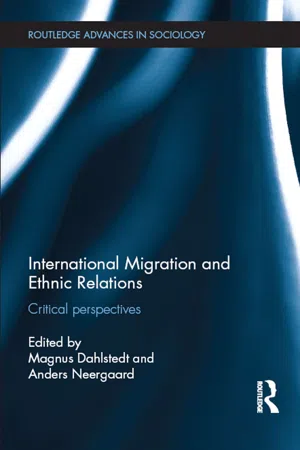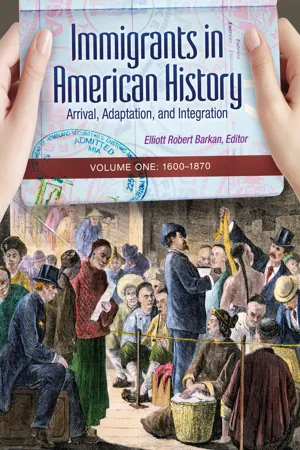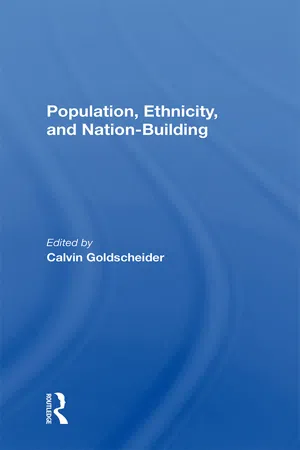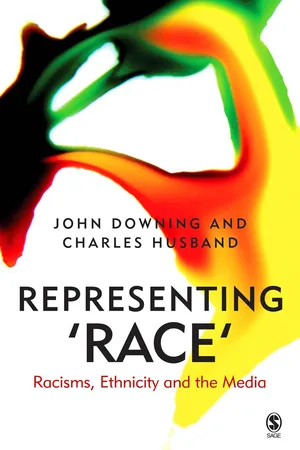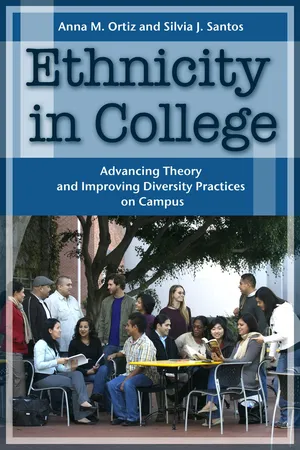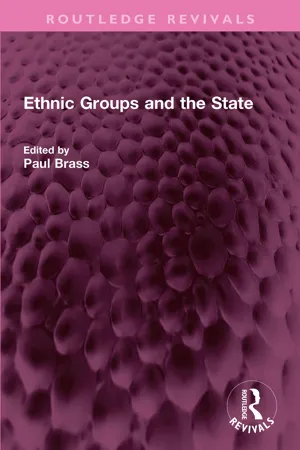Social Sciences
Ethnic Groups in America
Ethnic groups in America refer to the diverse cultural, racial, and national backgrounds of people living in the United States. These groups contribute to the rich tapestry of American society, bringing unique traditions, languages, and customs. The study of ethnic groups in America encompasses their history, experiences, and contributions to the country's social, political, and economic landscape.
Written by Perlego with AI-assistance
Related key terms
11 Key excerpts on "Ethnic Groups in America"
- eBook - ePub
International Migration and Ethnic Relations
Critical Perspectives
- Magnus Dahlstedt, Anders Neergaard(Authors)
- 2015(Publication Date)
- Routledge(Publisher)
The purpose of this chapter is to describe the basic theoretical approaches in research on ethnicity and nationhood and to illustrate with the help of empirical examples how the two concepts intersect. Key themes and areas of concern are discussed from an integrated perspective, where ethnicity and nationhood are seen as connected. We argue that these concepts convey the idea that a community is based on cohesion, boundary maintenance and cultural differences, or a combination of these. We begin the chapter with an overview where we describe the main lines of the debates surrounding the concepts of ethnicity and nationhood in an academic context. Afterwards we illustrate the importance of different interpretations of the concepts. Our examples are drawn from the educational context because the school is a central arena for fostering and transmitting dominant perceptions of ethnicity and nationhood.The concept of ethnicityWhat is ethnicity? It is used in everyday, political and academic contexts to describe social groups, commonly referred to in terms of cultural markers such as common origin, language, norms, cultural practices and religion. Cultural markers are usually connected with concepts such as ethnic identity or ethnic identification, which in turn are used to denote individuals or groups of individuals who identify themselves or are identified by others in terms of ethnicity (Johansson 1999; Brubaker 2004). Minority groups, such as indigenous people and territorial minorities, are, as well as migrants, often described in ethnic terms, in both everyday language and social research. Ethnicity can be further understood as a form of social organization, as a social group category, marked by what is often perceived as shared culture, and it is at this point that ethnicity in the academic context becomes contentious (Ålund 2003). Is ethnicity a dynamic and changeable or a static phenomenon? How are ethnic boundaries created and maintained? How do the creation and maintenance of ethnic boundaries relate to nationhood? Are so-called hyphenated identities, created through the processes of ethnic boundary creation, connecting two or more national identities or do they connect a national identity with an ethnic one?In this chapter, we approach ethnicity as a complex socio-cultural category that intersects with a number of others such as social class, gender and age. For migrants ‘near’ and ‘far’ are brought together, connecting memories and experiences from different worlds, as their sense of identity is affected both by global processes and local experiences. Their life stories and identity creation evolve from both their specific experiences of time and space as well as their social positions in terms of ethnicity, class, gender and age and their insider and outsider positions (see Chapter 5 , Intersectionality - eBook - ePub
Immigrants in American History
Arrival, Adaptation, and Integration [4 volumes]
- Elliott Robert Barkan, Elliott Robert Barkan, Elliott Robert Barkan(Authors)
- 2013(Publication Date)
- ABC-CLIO(Publisher)
Ethnic Groups and Ethnicity
Joseph F. HealeyThe focus of this chapter is on the United States and American ethnic groups, but other nations and situations will be mentioned. In particular, we focus on the ethnic groups created by two mass immigrations to the United States, the first from the 1820s to the 1920s, and the second beginning in the 1960s and much more diverse.What Is an Ethnic Group?
Five characteristics describe and define ethnic groups: They share (1) a distinct cultural heritage and (2) a common identity and a belief in a common ancestry or place of origin. Ethnic groups also (3) maintain a network of social relationships, groups, and organizations separate from the surrounding society. Membership in ethnic groups is (4) an ascribed status, or commonly (but not in all cases) determined by birth, and the members (5) tend to be endogamous—marrying within the group.A Distinct Cultural Heritage
An ethnic group has a cultural heritage that is noticeably different from other groups in their society. It includes customs, values, language, religion, cuisine, traditions, folklore, and many other components. Examples of cultural traits that identify ethnic group membership include the celebration of Hanukkah for Jews; the Irish wake to mark the passing of a loved one; ranchera music for Mexican Americans; the Creole language for Haitians; West Indian Carnivale; the simple, homemade clothing of the Amish; and the Chinese New Year. The cultural heritage helps to mark the boundaries of the group, providing a focus of identity and making the group more visible to both members and the larger society. However, the cultural dimension is not alone sufficient to define ethnicity, and, conversely, not all groups that share a culture are ethnic groups. Surgeons, professional baseball players, Republicans, jazz fans, and labor union members each collectively share values, information, customs, and experiences that make them identifiable, but they are not “ethnic groups.” - eBook - ePub
The Political Participation of Asian Americans
Voting Behavior in Southern California
- Pei-te Lien(Author)
- 2018(Publication Date)
- Routledge(Publisher)
Before the relationship between ethnicity and political participation can be meaningfully discussed and analyzed, it is necessary to define the meanings of ethnicity, Asian American panethnicity, and political participation as adopted by this study. Perhaps because of the difficulty in drawing a clear conceptual fault line between race and ethnicity, these two broad terms have often been used interchangeably in the existing literature (Torres and Ngin 1995). Thus, a discussion of the meanings of ethnicity may include considerations of the role of race. Similarly, ethnic politics may be conceived of being no different than racial politics. This lack of distinction between race and ethnicity, though widely accepted, may become a source of confusion and friction when some ethnic group members are of nonwhite races or when a nonwhite racial group is composed of individuals with different ethnic and national origins. To help mitigate the problem, a third term, panethnicity, is adopted by this study as a special case of ethnicity to refer to the incidence of a collective group identity for a multiethnic, racialized group such as Asians.Ethnicity
Ethnicity can be defined as a sense of belonging to "an involuntary group of people who share the same culture" or are perceived by others as sharing the same culture (Isajiw 1974, 122). Expressions of ethnicity for minority groups are complex and always occur against a backdrop of at least two levels of identification—with one's own ethnic group and with the dominant group (Yinger 1985; Hutnik 1986). For groups undergoing status change, the double boundary is often maintained from within by the socialization process and from without by the process of intergroup relations (Barth 1969; Isajiw 1974). For groups that have a recent history of international migration and are experiencing rapid changes in their population composition and socio-political position, the concept of culture, however, refers much less to an unmediated heritage than to socially constructed boundaries which can be created and re-created to organize group members (Roosens 1989). Immigrant group identity, therefore, is an "emergent phenomenon" rather than a static construct (Yancey, Ericksen, and Juliani 1976). Far from being an essence or something fixed, concrete, or objective, ethnic/racial identity is formed through the interaction between subjective identification and objective conditions and is constantly transformed by political conflicts (Omi and Winant 1986). - eBook - ePub
- Catharine R. Stimpson, Gilbert Herdt, Catharine R. Stimpson, Gilbert Herdt(Authors)
- 2014(Publication Date)
- University of Chicago Press(Publisher)
4 : : ETHNICITYANNA SAMPAIOEthnicity is a fundamental form of social and political organization that serves as a tool for the construction of group and personal identity. Like gender, race, and class, it is a socially constructed marker that binds individuals to larger groups and associations by emphasizing a common past within a contemporary identity. While the precise definition of ethnicity has been contested, resulting in variations over time, today ethnicity typically refers to the shared customs, cultures, and traditions of a group of people, including such aspects as common language, religion, food, and music, as well as collective histories of discrimination and resistance to it.Ethnicity as a concept gained popularity among academics during the great wave of immigration from Europe to the Americas at the beginning of the twentieth century. Between 1920 and 1950, social scientists increasingly turned to theories of ethnicity as an alternative to racist theories that suggested that one’s status and position in society was strictly a function of biological heritage. Drawn by a desire better to understand the changing composition of the country brought on by a large wave of new immigrants to the United States from southern and eastern Europe, sociologists found concepts of ethnicity useful in analyzing and clarifying both the shared histories of these new Americans and the distinctions that kept them from becoming fully incorporated into the country. These groups came to be understood as ethnic minorities, namely, populations who shared a similar racial makeup with the dominant class of Anglo-Saxons and northern and western Europeans, but who held distinct customs, traditions, and even linguistic practices that set them apart and made them seem different. Ethnicity became a source of support and strength for immigrants as they faced both hostility and strong incentives to “assimilate”—to give up their unique cultural past in order to melt into the common definitions of Americanness and whiteness. Some members of ethnic minorities sought refuge among neighbors and people who shared their cultural history, leading eventually to the formation of ethnic enclaves across the United States. - eBook - ePub
- Calvin Goldscheider(Author)
- 2019(Publication Date)
- Routledge(Publisher)
Every wave of population migration that involves different ethnic groups (including both international migration and internal migration of minority groups) heightens concerns about the ability of groups to associate. The flood of immigrants from southern, eastern, and central Europe at the turn of the century led many scholars, historians, and statesmen in America to decry what they perceived as a dangerous weakening of the American character, due to the influx of "inferior" immigrants. Similar sentiments are expressed today about the most recent immigrants, who, like the immigrants at the turn of the century, are not from locations where the majority of the United States population claims ancestry. Tensions over adherence to languages other than English; familiarity with urban industrial settings; and competition for jobs are some of the similarities between the debates that ensued at the turn of the century and those occurring today. These questions concerning ethnic minorities have made their way into the present-day arena of public discussion. Are these different groups able to assimilate into the majority culture (however defined)? Is the host society itself able to accommodate or adapt to these minorities? Are either of these goals desirable?In this paper we explore several issues related to ethnic identity in the United States. We employ demographic tools, including qualitative analysis of historical census schedules and statistical analysis of census and survey data from 1910 and 1980. Our purpose is to provide direct evidence on ethnic group competition and assimilation, and to call attention to how these issues of ethnic identification and assimilation are intertwined with the data collection mechanisms used by official agencies.We first examine the issue of ethnic identity itself. It is common practice for social scientists and others to treat ethnicity (including race) as an immutable trait. Yet ethnic identity is partly a matter of self-identification; partly a matter of labeling by others in society, and partly a collective response to the particular array of groups present in the host society. Our window on the perception and measurement of ethnicity is provided by decennial census schedules. On the one hand, these census documents represent the "official" ethnic group identities recognized or imposed by the government. On the other hand, these categories frame the forms of analyses that can be conducted, and have a bearing on some of the results that can be developed.For the purposes of this paper, our notion of ethnicity is a very inclusive one. Many definitions of ethnic group and racial group exist. We take ethnicity to represent a membership in a social subgroup whose basis for commonality arises out of cultural physiognomic, and linguistic traits passed on by birth. For our purposes here ethnicity will subsume national origin and race. Spanish origin and ancestry are also included for more recent decades; in the 1990 census the "ancestry" question used the term ethnicity. - eBook - ePub
Representing Race
Racisms, Ethnicity and the Media
- John D H Downing, Charles Husband(Authors)
- 2005(Publication Date)
- SAGE Publications Ltd(Publisher)
8This discussion is intended to provide a preliminary sensitization to some of the dilemmas raised by ethnicity as we briefly examine routes to an understanding of it provided by the social sciences. Ethnicity is not a stable property of an individual, implanted, like some microchip at birth. It is a continuous process of identity construction in which individuals participate collectively in defining and valorizing a group identity. One very simple definition of ethnicity is ‘cultures in contact’. This reminds us that a fundamental basis of ethnic group formation is an active negotiation of in-group and out-group identities. We become aware of our ethnicity when we interact with members of a different culture. But this awareness of difference must be based upon relatively stable markers of in-group and out-group ethnic identity. Inter-group social comparison essentially takes place in relation to relatively few important key variables (Turner et al., 1987). Thus, for example, language provides a wonderfully flexible means of declaring in-group affiliation. Not just ‘national’ languages, but modes of inflection, argot and transitory ‘in-words’ readily expose the outsider. Rather like the processes of defining national identity, ethnicity is tied up with an ability to recognize ‘those like us’ and exclude ‘those not like us’ from inclusion in our identity group. Eriksen has suggested that:Ethnicity occurs when cultural differences are made relevant through interaction. This concerns what is socially relevant, not which cultural differences are ‘actually there’. In an article on ethnic relations in Thailand, Michael Moerma (1965) has shown that many of his informants mention cultural particulars which they presume are characteristic of themselves but which they in fact share with neighbouring peoples. Indeed, a variety of criteria can be used as markers of cultural difference in inter-ethnic situations – phenotype (appearance or ‘race’), language, religion or even clothes. If any such marker is socially recognised as an indicator of an ethnic contrast, it matters little if the ‘objective cultural differences’ are negligible. (1995: 251) - eBook - ePub
Ethnic Marketing
Culturally sensitive theory and practice
- Guilherme Pires(Author)
- 2014(Publication Date)
- Routledge(Publisher)
et al. , 1998).Each of the Hispanics, Latinos and Asian-Americans segments is a huge market…. I think they are being targeted by lots of companies in the States because of their size. There are lots of advertising directed to them, and a lot of research done on the Latinos in the States. So, I think that it is a form of ethnic marketing because they live in the two cultural societies. As long as you live in two culture societies….Michel LarocheThe fact is that the Americans tend to say that Europeans are Europeans, but there is even a huge cultural difference between Finns, Swedes, Norwegians and Danes, who are supposedly four people speaking languages that are partly similar, but partly are not.Christian GrönroosA contrasting perspective combines views by some analysts of ethnicity as possibly ephemeral within advanced economies (Hofstede, 2001), with concerns about relative group smallness, such that aggregations of ethnic groups may be advantageous, given sufficient homogeneity, at least for particular marketing purposes.Ethnic groups are social constructs with boundaries constructed either through self-ascription, through group ascription (Vasta, 1993) or through ascription by others. In Australia, ethnic group membership results from ascription by self and by others, with government contributing to ethnic group construction (Langer, 1998: 170–75), in a process that has been identified as ‘inclusive particularism’ (Stratton and Ang, 1998: 156). Since an ethnic group consists of an aggregate of consumers sharing one ethnicity, a clear identification of consumer ethnicity is required to ensure group homogeneity and stability for segmentation purposes. This can be a complex task to accomplish, which may explain the use of indicators such as place of birth, nationality, language or other similar segmentation bases, although these may provide false estimates of group size, leading to potentially erroneous conclusions about group importance for marketing purposes. - eBook - ePub
- Marcus Banks(Author)
- 2003(Publication Date)
- Routledge(Publisher)
As should be evident to any student of social science, previous research tends to dictate the course of future research, so that countercurrent attempts such as Rex's to argue that there are (or were) certain class relations at specific moments in the history of capitalism that could profitably be analysed within a context of race relations theory (Rex 1986:21) tend, on the whole, to be ignored. We saw at the end of the last chapter how more recent anthropological theories of ethnicity have tended to refine earlier theories, often by adding an extra theoretical ingredient (praxis theory, nationalist ideology, language games). So too, theories of race—and anthropological theories of ethnicity in situations sociologists might call ‘race relations situations’— have tended to be cumulative in development, however much individual authors might vehemently proclaim their originality, or their refutation of all previous work. In order to reach an understanding of recent anthropological work on the ethnicity of minority migrant groups, we must therefore consider some earlier research on such groups. In the remainder of this chapter I consider the relevant literature for the United States. In the next chapter I turn to an examination of the literature on Britain.RACE AND ETHNICITY IN THE UNITED STATESThe literature on race and ethnicity concerning the United States alone is voluminous and a comprehensive survey is well beyond the scope of this chapter. We can impose a rough and ready order upon it, however, by dividing it into two groups: literature that is largely descriptive (and often survey based), and literature that is more analytical and contains theoretical insights into ethnicity. The first group is by far the larger and I shall refer to it less often in what follows. The works in this group tend to describe the pattern of race or ethnic relations in some area of the United States, either in general terms or—especially during the heyday in the 1960s and 1970s—with reference to some particular issue, such as education, or housing, or political representation. The particular topic investigated is often suggested by some perceived social problem in the United States at the time. These works rarely make any innovative statements about the nature of race or ethnicity as terms in the sociological discourse and tend to take a positivist or commonsense view of their subject of enquiry. The same attitude prevails when defining the population units to be studied, especially when individuals are selected for a questionnaire survey, as the following quotation reveals: ‘In general, it was not difficult to define a minority population by relying upon the commonly accepted local definitions. crude and simple as this method may seem. That is, “Negroes” were all persons so regarded by themselves and by other persons who clearly were themselves Negro. “Jews” were persons who regarded themselves as Jewish and were so regarded by others’ (R. Williams et al - eBook - ePub
Ethnicity in College
Advancing Theory and Improving Diversity Practices on Campus
- Anna M. Ortiz, Silvia J. Santos(Authors)
- 2018(Publication Date)
- Stylus Publishing(Publisher)
2 ETHNIC IDENTITY’S THEORETICAL AND RESEARCH TRADITIONS E thnic identity is perhaps best conceptualized as an enduring and fundamental aspect of the self-concept that derives from a sense of membership in an ethnic group, along with the ‘‘value and emotional significance attached to that group membership’’ (Tajfel, 1981, p. 225). Included in the meaning of ethnic identity are the attitudes, beliefs, values, behavioral norms, and expectations that members of a specific group share and that form the basis for differentiating and setting groups apart in society (Keefe, 1992; Phinney, 1990; Uba, 1994). This definition of ethnic identity clearly points to a complex and multidimensional construct comprising various internal (feelings and thoughts) and external (behaviors) elements (Phinney, 1996; Sodowsky, Kwan, & Pannu, 1995). Also captured in the literature is the view of ethnic identity as a dynamic and unfolding process that changes over time and context as a person examines and explores the meaning of his or her ethnic and/or racial group membership (Helms & Cook, 1999; Lee & Zane, 1998; Phinney, 1996; Ponterotto, Casas, Suzuki, & Alexander, 1995). Although the content of ethnic identity and the process of ethnic identity formation are interrelated, for the stake of clarity we address them separately. Furthermore, this chapter attempts to distinguish between ethnic and racial identity development. Ethnic Identity—A Focus on Content and Context Much attention has been given to examining the content of ethnic identity among American ethnic minority groups. 1 When addressing the content of ethnic identity and its relevant components, the focus has been on the state of an individual’s identification at a given time - eBook - ePub
- Paul R. Brass, Paul R. Brass(Authors)
- 2023(Publication Date)
- Routledge(Publisher)
ETHNIC GROUPS AND THE STATE by Paul R. Brass DOI: 10.4324/9781003372059-1I. INTRODUCTION
The theme of this volume is the effects of the state, its official ideologies, its structural forms, its alliance strategies, and its specific policies upon ethnic identity formation. Ethnic identity formation is viewed as a process that involves three sets of struggles. One takes place within the ethnic group itself for control over its material and symbolic resources, which in turn involves defining the group's boundaries and its rules for inclusion and exclusion.[1 ] The second takes place between ethnic groups as a competition for rights, privileges, and available resources. The third takes place between the state and the groups that dominate it, on the one hand, and the populations that inhabit its territory. Its focus is on the maintenance and extension of its control over local territories and populations and the provision of qualified manpower to administer its institutions, implement its policies, and create wealth, power, and safety for itself and its inhabitants. These three sets of struggles intersect in different ways at different times, but it is possible to specify particular patterns of elite competition within and between ethnic groups, the role of the state in each pattern, and the potential consequences of each pattern for ethnic identity formation and political mobilization.Most available theories that touch directly or indirectly on the issue of the relationship between ethnic groups and the state are deficient in one or more respects to deal adequately with the issues raised in this volume. Several problems recur in the literature on ethnic groups and the state that prevent a proper appreciation of the role of the latter in relation to internal struggles for control of ethnic communities and in relation to competition between ethnic groups. One recurring problem concerns the treatment of the state, that is, whether it is to be seen as an instrument of a class or an ethnic group or as a relatively autonomous force, whether it is to be seen as a distributor of privileges or a promoter of justice and equality among groups, whether it is to be seen as an impartial arena for conflict resolution or a partial intervenor in societal conflicts. A second set of problems concerns the categories to be used in the analysis of society and how they are to be defined. Is the study of ethnicity a sub-branch of interest group politics or of class analysis or a separate subject of study in its own right? Or, to put it another way, are interest groups, classes and ethnic groups to be treated as analytically separable and coequivalent or is one or another category primary? A third set of problems concerns the level of analysis and the central theoretical issue or issues. Most sociological theories that are relevant to a discussion of ethnic groups and the state focus on society as a whole and take as their main theoretical issue the conditions for conflict or cohesion, national integration or internal war and treat the societal units—interest groups, classes, or ethnic groups--as givens rather than as objects for examination themselves. Too often neglected is the issue of how identity and cohesion within groups are formed and maintained in the first place, how political mobilization of groups occurs, and how and why both group cohesion and mobilization often decline. It is not that there is no literature on the latter question, but that its insights tend to be neglected when scholars move to the societal level. - eBook - ePub
- Merlin Chowkwanyun, Randa Serhan(Authors)
- 2015(Publication Date)
- Routledge(Publisher)
While “racial groups” were subordinated and excluded through caste restrictions on residential, occupational, associational, and marital choice, the clash of “ethnic groups” with the dominant institutions of the host society was not much of a contest, particularly among the young. The industrial economy, the polity, the public school, popular culture, and the American family system all undercut and absorbed ethnicity in various ways, so that even when “the ethnic parent tries to orient the child to an ethnic past… the child often insists on being more American than Americans.” 52 For the upwardly mobile, with socioeconomic success came intermarriage and the further dilution of ethnicity. They concluded that “it is the degree of racial difference from the white American norms which counts most heavily in the placement of the group and in the determination of its assimilation”; absent such discrimination and structural inequalities, however, “the future of American ethnic groups seems to be limited; it is likely that they will be quickly absorbed.” 53 That general if decidedly qualified view of assimilation as linear progress, with sociocultural similarity and socioeconomic success marching in lock step, was significantly refined by Milton Gordon in Assimilation in American Life (1964), published ironically on the eve of the beginning of the latest era of mass immigration to the United States—and of the denouement of the concept itself in the wake of the 1960s. From the opening sentence of the book, Gordon focused on the relational and contextual character of the process: “This book is concerned, ultimately, with problems of prejudice and discrimination arising out of differences in race, religion, and national background among the various groups which make up the American people.” 54 Although he meticulously reviewed a wide variety of definitions of “assimilation” in the scholarly literature, he did not explicitly provide his own
Index pages curate the most relevant extracts from our library of academic textbooks. They’ve been created using an in-house natural language model (NLM), each adding context and meaning to key research topics.
